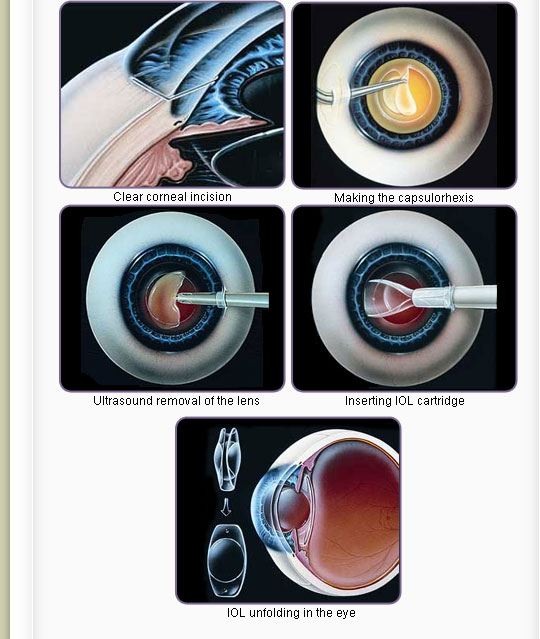| Cataract Surgery and Intraocular Lens Technology |
IOL Implantation: Procedures and Instrumentation
Cataract Extraction Procedures
Ophthalmologists perform two main types of cataract surgery extraction to allow for IOL implantation:
1.) Phacoemulsification (phaco)

Also known as “small incision cataract surgery,” phaco starts with a small incision (approximately 1.8 mm to 2.8 mm) at the corneoscleral junction (watch a complete phaco surgery here). A viscoelastic gel is then injected into the anterior chamber for stabilization of the lens. Capsulorhexis surgical forceps are introduced into the incision to perform a continuous curvilinear capsulorhexis, a procedure to open a portion of the anterior lens capsule for emulsification of the cortical material. Once entry into the interior of the lens is established, an ultrasonic handpiece (capable of producing vibrations of up to 40,000 Hz) is used for hydrodissection or the emulsification of the lens nucleus (see table and figure below). A second instrument called a chopper may be used from a side port to facilitate destruction of the nucleus into smaller pieces. Fragmentation into smaller pieces makes emulsification easier, as well as the aspiration of cortical material. After phacoemulsification of the lens nucleus and cortical material is completed, a dual irrigation-aspiration (I-A) probe or a bimanual I-A system is used to aspirate out the remaining peripheral cortical material. The capsular bag now remains and can be implanted with an IOL.

or
2.) Extracapsular cataract extraction (ECCE) surgery

Though phaco is the preferred method for cataract removal, patients with more advanced/severe cataracts or other ocular disorders that may complicate phacoemulsification are treated with the more conventional extracapsular cataract extraction surgery. ECCE involves a much larger incision (approximately 10-12 mm) at the corneoscleral junction. An entry way into the lens is created with the same capsulorhexis procedure as with phaco but a larger suction device is introduced to remove the lens nucleus as a whole (as opposed to emulsification followed by aspiration). The emptied capsular bag is now ready for IOL implantation.
or
3.) Intracapsular cataract extraction (ICCE) surgery
ICEE is a much simpler, but outdated, procedure involving the removal of the lens and the surrounding lens capsule as a whole. The lens is then replaced with an IOL of appropriate power which remains permanently in the eye. The procedure has a relatively high rate of complications due to the large incision required and pressure placed on the vitreous body, thus is rarely performed in countries where operating microscopes and high-technology equipment are readily available.
IOL Implantation
After the removal of the cataract via one of the two methods described above, an IOL is implanted into the lens capsular bag (foldable lenses accompany phaco procedures while while non-foldable lenses are implanted following ECCE - click here for a video). The foldable IOL, made of silicone or acrylic material of appropriate power is folded either using a holder/folder, or a proprietary insertion device provided along with the IOL. Unfoldable lenses are also available in many materials. Further details regarding lens design and characteristics are discussed here.
All Right Reserved © 2007 by H Sin